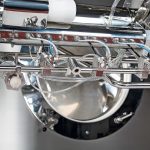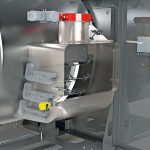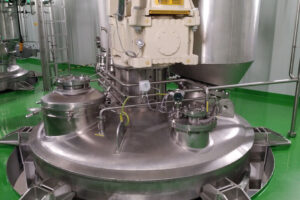The newly developed TP R Optima coater enables tablet coatings of all kinds to be produced fully automatically for a wide range of batch sizes. The recipe with the predefined process parameters can be accessed by the machine operator on the HMI and is then running automatically. Parameters like the spray distance or angle no longer have to be adjusted (or re-
adjusted) manually nor do the exhaust air flows. The parameters are monitored continuously during the coating process and automatically adapted by the system to the recipe. The operator is no longer required to be present throughout and is freed up for other assignments.
This highly automated coater delivers absolutely reproducible results and optimal process control is guaranteed, because all manual intervention during the coating process is eliminated. For example, sampling can take place directly without having to stop coating and open the machine.
Sonar system measures batch volume
The key to the TP R Optima tablet coater’s ability to adjust the parameters fully automatically during the coating process lies in a sonar. Acoustic wave sensors measure the complete tablet bed continuously and then use this information to determine the batch volume. The tablet bed inclination, which varies according to the turning speed of the drum, is measured in the same way.
Therefore, the new perforated coating pan from Romaco Tecpharm allows ultra-precise application of the spray liquids over the entire batch size range from ten to 100 %. This is achieved thanks to the interaction between the sonar’s real-time data and a newly developed nozzle arm with a three-point extension mechanism, which automatically adjusts the spray angle and distance without interrupting the coating process. The nozzle arm’s long reach ensures that the suspension is always applied to the tablets exactly as per the recipe, even with very small batch sizes.
Efficient spraying and drying process
Drying is a particularly important step in the tablet coating process, which begins while the spray liquid suspension is being applied. The inlet and exhaust air temperature and flow rate are crucial to the efficiency of the spraying and drying process, as is correct air flow behaviour in relation to the batch size. Near loss-free application of the suspension and rapid drying will otherwise be impossible. It is also extremely important to adjust the drying air, to prevent the product in the coater from becoming too moist, causing individual tablets to stick together.
The TP R Optima tablet coater uses a bypass to adjust the supply of process air. The vacuum that is created inside the drum can be varied according to the batch size; it stabilises the air flow and diverts the air towards the automatic air exhaust flaps. These flaps can be opened individually and continuously in a controlled way, so that the process air is guided through the product directly. The coater’s high spraying and drying efficiency thus achieved is reflected in short processing times – generally between one and three hours depending on the product – as well as lower energy usage.
The precise control of the air flow inside the drum also means accurate application of the coating suspension to the product for any batch volume between ten and 100 %. In other words, the system prevents that the liquid just runs over the tablets and is discharged without being applied. Together with the high spray accuracy which results from the automatic adjustment of the spray arm, this adds up to lower consumption of coating suspension – and a material saving of up to 60 % compared to other coating methods, depending on the application.
Clearance of clogged spray nozzles
The newly developed coating technology includes a system for automatically detecting and clearing clogged spray nozzles. The risk of such blockages occurring is actually very low in practice but increases the higher the suspension’s viscosity. Directly downstream of the peristaltic pump, the newly developed coating pan has a load cell that measures the amount of spray liquid being pumped. If the load cell registers that liquid is no longer exiting from one of the nozzles, the coater initially attempts to unclog that particular nozzle by building up maximum pressure. If this is not possible, an individually configurable mechanism takes over: depending on the product being processed, either the coating process continues and the system simply issues an alert or the process is interrupted immediately. The coating pan’s response to nozzle blockages can be fine-tuned to the product in question in this way.
GMP-compliant in-wall design
The TP R Optima tablet coater was designed in conformity with GMP (Good Manufacturing Practices) standards. All product-contacted parts on the inside of the coater are easy to clean using WIP (washing in place) procedures and readily accessible, so that cleaning validation is totally straightforward. No dead spaces exist where product residues could accumulate, leading to cross contamination. The design of the spray arm particularly rules out such critical spaces due to its extendable and retractable mechanism.
Furthermore, the tablet coater’s in-wall design enables strict separation between the “grey” area and the production area in the cleanroom. If servicing is required, the work can be carried out without having to enter the cleanroom and decontaminate it again afterwards. What is more, the batch being processed does not necessarily need to be disposed of following a service assignment in the “grey” area and can be processed further once the work is completed.
Romaco Group, Karlsruhe











